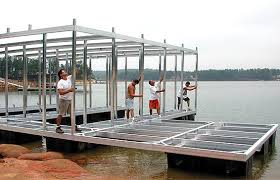A well-constructed dock provides convenient access to the water for boating and other recreational activities. It also increases property value and adds to the enjoyment of living near the water.

The foundation of a dock is crucial to its long-term durability and safety. Engineers design the pile foundation to accommodate both static loads (constant forces) and dynamic loads (transient stresses) from environmental conditions and operational activities. Contact Charleston Dock Works for professional help.
Dock construction is a specialized aspect of marine engineering that requires the use of materials that are strong, durable, and able to withstand the harsh marine environment. A variety of materials are used in dock construction, from traditional wood to composite and aluminum materials. Each material has its own advantages and disadvantages, so selecting the right one depends on how you plan to use your dock.
The first step in building a dock or pier is conducting a thorough site assessment to determine water depth, soil conditions, and tidal fluctuations. It is also important to consider local regulations, including zoning laws and environmental protection measures. The type of dock or pier you choose will depend on these factors as well as your budget and design preferences.
For example, if you live in a location that experiences significant tidal fluctuation, it may be more cost-effective to build a floating dock than a stationary or piling dock. In contrast, a residential wood dock provides a classic look and is suitable for locations with stable water levels.
Dock brackets are essential parts of any dock construction project. They are designed to distribute and hold the weight of the dock, and they come in different styles to fit any aesthetic. For a residential or commercial marina, steel dock hardware is a good choice because it can withstand the harsh marine environment. For a saltwater application, however, stainless steel is preferred because it resists corrosion better than galvanized metal.
A dock wheel mounting kit is a useful tool for removing your dock from the water in winter. It enables you to roll out the dock from the water without using manual labor or heavy equipment. These kits are also useful for adjusting the height of the dock in response to changing weather conditions.
Many dock owners choose to decorate their docks with benches, stairs, and other accessories. You can also add lighting and a non-slip surface to make the deck more usable. These features will enhance the appeal of your dock and increase its value if you ever decide to sell it.
Design
The intended use of a dock dictates its structural specifications, materials, and design. For example, a marina dock must be robust enough to support large boats and other water vessels, while a residential dock may focus on aesthetics and user comfort. In addition, local regulations and environmental concerns influence the construction and maintenance of docks. For example, many regions require that docks be built on permitted sites. The permit fee is dependent on the size and scope of the dock, so be sure to consult local authorities before constructing a dock.
The dock’s foundation is a critical underpinning that transfers forces from the deck to the seabed or lake bed. The most common foundation solutions include fixed piers and pile systems. Fixed piers are typically more affordable and suit lakes or rivers with constant water levels. Pile systems are designed for more challenging environments where the water level fluctuates.
A thorough load analysis is an essential step in ensuring the dock’s structural integrity. Engineers must evaluate both static loads (constant forces) and dynamic loads (transient forces from operational activities or movement of vehicles).
Once the dock’s superstructure and load requirements are established, designers must determine the best material and construction method for the foundation. Whether a dock is constructed of wood, concrete, or metal, each choice has its own benefits and drawbacks. Wood options are generally cheaper, but they are prone to rot and require regular maintenance. Concrete and metal are more expensive, but they offer greater durability and long-term value.
Mooring systems are also an important consideration for docks that will accommodate vessels. Effective mooring systems will allow for quick attachment and removal of vessels while maintaining a safe connection with the dock.
A careful layout of the dock is also crucial for efficiency. Traffic patterns must be clearly defined to reduce accidents and ensure that operators have clear access to equipment and vehicles.
Planning
A well-constructed dock is an essential component of any waterfront property. It provides a safe and secure location for mooring boats, providing access to the water, and enabling activities like fishing or recreational boating. Building a dock requires careful planning and the use of specialized materials to ensure durability and safety.
In coastal areas, a dock’s structure must address the unique challenges of the marine environment. This can include addressing corrosion and structural degradation, integrating new technologies for operational efficiency, or upgrading the load-bearing capacities of existing structures. Whether for commercial or private use, a dock’s design must also incorporate environmental considerations to ensure sustainable operation and long-term durability.
The construction of a dock begins with the foundation, or pilings. Pilings are vertical posts that transfer the weight of the dock to more stable soil or rock layers beneath. The choice of pile material — steel, concrete, or timber — depends on site conditions and anticipated loads. A piling system’s integrity determines the dock’s ability to withstand dynamic forces caused by waves, currents, and cyclical tidal patterns.
Once the pile foundation is established, the superstructure of the dock can be built. This includes the decking, hardware, and anchorage systems that define the dock’s visual and functional features. Aside from aesthetic considerations, it is important to choose a location that provides enough water depth and saves the dock from harsh weather conditions. In addition, it is important to account for tidal fluctuations and the underlying water level, which can affect how much of the structure will be submerged at any given time.
In addition, dock construction involves preparing the worksite and ensuring worker safety. This is especially crucial during the construction phase when pile driving operations may require the use of heavy equipment. The requisite preparations include providing workers with proper personal protective equipment and training, establishing staging areas for equipment assembly and maintenance, and ensuring that all work meets strict quality and safety protocols. Ultimately, this helps reduce the risk of costly errors that could compromise the structural integrity of the dock.
Installation
A dock is the defining feature of waterfront property and an essential component of recreational and commercial marine operations. It enables easy access for boating, serves as a tranquil escape, and increases the overall value of homes with coastal or lakefront locations. When homeowners and business owners decide to construct a dock, the first question often revolves around how much it will cost. The answer is more nuanced than a simple, flat figure, as several factors that align with the construction process shape the final cost of a new dock.
The primary component of any dock is its decking system, which forms the platform on which operations are conducted. The design and materials chosen for the decking system greatly impact functionality and durability in a marine environment. Precast concrete decking systems, for example, are manufactured offsite under controlled conditions and transported to the construction site for installation. This approach offers high quality control, faster installation times, and consistent material properties that contribute to a robust deck surface.
Beyond the primary decking, a dock’s superstructure must be designed to accommodate operational loads and environmental stresses. A flexible design strategy and load distribution techniques are critical for managing these forces, minimizing the risk of localized failure and prolonging the service life of the dock.
Effective mooring systems are also integral to the dock’s overall integrity and performance. These systems are designed to accommodate a wide range of vessel sizes and types and must be capable of adapting to changing sea conditions.
The location on which a dock is constructed is also crucial. A rocky shoreline or steeply sloped lake bottom might necessitate additional structural reinforcements, while soft, muddy areas require special anchoring systems to prevent sinkage. The water depth and consistency of the surrounding lake bottom can also impact the type of dock that is most appropriate, as fixed piers are better suited for lakes with minimal fluctuation in water levels, while floating docks offer greater flexibility in environments with large tidal ranges. A dock’s intended use will further dictate requirements for safety features, including adequate lighting, non-slip surfaces, and emergency communication systems.
